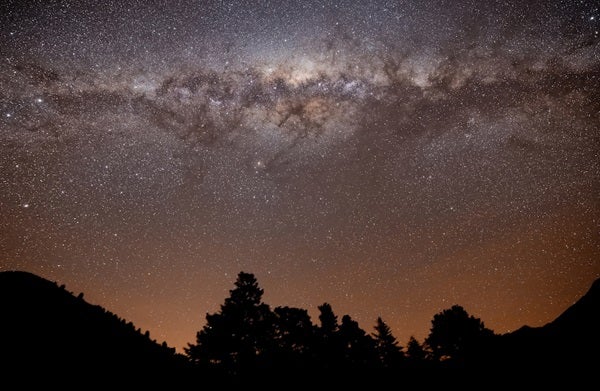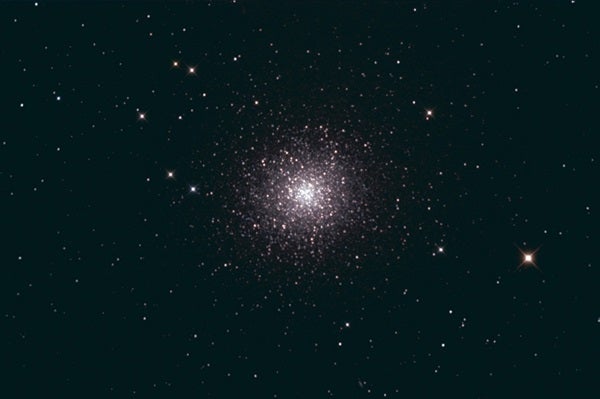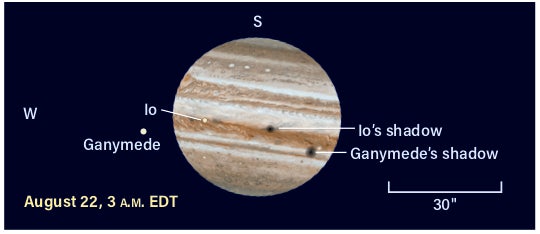Although the Perseid meteor shower peaked earlier this week, there’s still a chance you may see errant shower meteors as it slowly winds down. Especially with the Moon waning by the day, try stepping out for a little while each evening (or morning) to spend some time scanning the skies for meteor trails.
Because the Moon is such a slim crescent over the next few days, it’s also a great opportunity to look for earthshine. This phenomenon, which lights up the portion of the Moon’s face otherwise in Earth’s shadow, occurs when sunlight reflects off Earth and hits the Moon. The amount of light Earth reflects actually varies throughout the year; earthshine is most likely to occur during spring in the Northern Hemisphere, when northern latitudes are tilted toward the Sun but often still covered in snow. However, earthshine can occur at any time, so it’s always worth a glance at our satellite to see if you can spot it.
Sunrise*: 6:11 A.M.
Sunset: 7:57 P.M.
Moonrise: 1:28 A.M.
Moonset: 4:46 P.M.
Moon Phase: Waning crescent (22%)
*Times for sunrise, sunset, moonrise, and moonset are given in local time from 40° N 90° W. The Moon’s illumination is given at 12 P.M. local time from the same location.

Observing the night sky is a fun and easy activity that anyone can do. Astronomy has compiled some of our best advice into our newest free downloadable ebook: Observing The Night Sky for Beginners.
Venus shares the eastern sky with a waning crescent Moon this morning. Both are in Gemini the Twins, easily visible in the two or three hours before sunrise. The pair resides near the twins’ feet — in fact, Venus is less than 0.5° from magnitude 4 Nu (ν) Geminorum, a multiple-star system containing two or three stars (astronomers still aren’t sure).
Venus itself glows at magnitude –4.4. It appears 23″ wide and is 51 percent lit, while our Moon is 16 percent lit. By sunrise, the Moon is a about 3.5° from Venus. The Moon will pass 4° north of the planet at 9 A.M. EDT.
Uranus is stationary at 1 P.M. EDT. If you’ve been watching the planet recently, you’ll have noticed its motion northeastward against the background stars. After tonight, it will about-face and follow nearly the same path southwestward. We’ll return to the ice giant tomorrow morning for a closer look.
Sunrise: 6:12 A.M.
Sunset: 7:56 P.M.
Moonrise: 2:14 A.M.
Moonset: 5:44 P.M.
Moon Phase: Waning crescent (14%)
Sunday, August 16
Uranus rises late on the 15th and is visible all morning on the 16th. An hour before sunrise, the planet is high in the southeast amid the stars of Aries the Ram. You should be able to spot its magnitude 5.8 glow easily with binoculars or a telescope. There are no other bright stars nearby, so look for a lone star that appears “flat” and somewhat gray-green. Its disk is just 4″ across. If you’re having trouble finding it, use a star chart to locate the bright stars Hamal in Aries (magnitude 2) and Menkar in Cetus (magnitude 2.5). Uranus lies roughly midway on a line connecting the two.
Roughly 20° east-northeast of Uranus is the easily recognizable Pleiades star cluster, also listed as Messier 45. Even without binoculars or a scope, you can enjoy the view; if you do use optical aid, opt for a larger field of view to encompass as much of the cluster as possible, which covers 110′ on the sky. And just 12.5° southeast of the Pleiades is a looser cluster, the Hyades, covering 330′. The bright star Aldebaran stands out against their scattered glow.
Sunrise: 6:13 A.M.
Sunset: 7:55 P.M.
Moonrise: 3:11 A.M.
Moonset: 6:37 P.M.
Moon Phase: Waning crescent (7%)
Monday, August 17
Mercury is in superior conjunction at 11 A.M. EDT. Although it’s impossible to see the planet in the glare of the Sun right now, it will briefly pop into visibility in the evening later this month.
Tonight, consider taking an astronomical history lesson. Start by locating Polaris. Also known as the North Star, Polaris sits above our planet’s North Pole. Despite its importance, this star is a mere magnitude 2 — not anywhere among the brightest stars in the northern sky. It lies at the end of the Little Dipper’s handle, while the Little Dipper itself is an asterism within the larger constellation of Ursa Minor the Little Bear.
Once you’ve found Polaris, follow the curve of the Dipper’s handle to locate the four stars that make up its cup. The brightest of these is Kochab (Beta [β] Ursae Minoris), just a smidge fainter than Polaris. Now, imagine the curve of the handle continuing south just a little farther: About 10° from Kochab is Thuban, the magnitude 3.7 alpha star of Draco the Dragon. And 5,000 years ago, Thuban was the North Star.
That’s because Earth’s tilt is wobbly; as our planet spins over time, its poles trace out a circle in the sky over tens of thousands of years. This is called precession, and it’s the same thing that happens to a slow-spinning top. Polaris is roughly 43′ from Earth’s North Pole today; around 2,800 B.C., Thuban sat less than 5′ from the pole.
Sunrise: 6:14 A.M.
Sunset: 7:53 P.M.
Moonrise: 4:14 A.M.
Moonset: 7:24 P.M.
Moon Phase: Waning crescent (3%)
New Moon occurs today at 10:42 P.M. EDT. That makes it a great day to seek out dim objects that are too hard to see when the Moon brightens the background sky.
If you’re in a dark location, one may immediately pop out: the gauzy glow of the Milky Way, stretching through Cassiopeia and Cygnus through Scutum, Sagittarius, and Scorpius. The Milky way is a spiral galaxy with an elongated, bar-like central bulge and several arms of dust and gas winding around it. Every star you see in the sky is in the Milky way, but what you’re seeing when you see “the Milky Way” in the sky is the plane of our galaxy’s disk, which is relatively flat (and which we are inside). The hazy light is actually from stars so numerous your eye can’t separate them, and instead they simply blend together into a soft glow. You may also notice darker patches, particularly in the south. It’s not that there are fewer stars in these patches, but that there is more dust, which blocks the starlight from shining through and makes these regions look dark.
If you’re looking early in the evening, Zeta and Eta are the two Keystone stars closest to the ground; the constellation will rotate slightly as the hours tick by, until Zeta is closest to the ground and Eta is to its upper right. M13 is closer to Eta and covers a little over 16′. It’s easy to resolve with even a three-inch telescope. There are more than 100,000 stars in this ancient cluster, which sits roughly 25,000 light-years from Earth.
Sunrise: 6:15 A.M.
Sunset: 7:52 P.M.
Moonrise: 5:25 A.M.
Moonset: 8:05 P.M.
Moon Phase: New (0%)
Wednesday, August 19
Tonight is the night asteroid 7 Iris makes a hairpin turn against the background stars. Two hours after sunset, Iris is about 30° high in the south, smack dab in the middle of our dusty Milky Way. Tonight, magnitude 9.8 Iris is less than 1′ from the magnitude 9.5 star SAO 160874, as the rocky body swings around this luminary and abruptly reverses course from westward to eastward motion. Although it’s moving quickly, it’s not making leaps and bounds; it will move only about 0.5° west by the end of the month. Return to this spot often to watch it ooze position night by night.
There’s also an added bonus nearby: The beautiful open star cluster M23 is less than 1.5° due northeast of Iris’ position tonight. Containing more than 170 stars and covering 23′ on the sky, you’ll also need binoculars or a small scope to see this young cluster, which lies over 2,000 light-years away. Iris, for comparison, is less than twice the Earth-Sun distance from our planet.
Sunrise: 6:16 A.M.
Sunset: 7:50 P.M.
Moonrise: 6:38 A.M.
Moonset: 8:41 P.M.
Moon Phase: Waxing crescent (1%)
Thursday, August 20
Take continuing advantage of the dark evening skies this week by aiming at a lesser-known but familiar-shaped nebula: The North America Nebula. Also cataloged as NGC 7000, the North America Nebula is about 3° east of the bright star Deneb, which marks the tail of Cygnus the Swan and is one of the three stars that make up the Summer Triangle. This emission nebula is best seen through 7×50 binoculars or a modest telescope, and appears somewhat dim because of its larger surface area. Nonetheless, give yourself some time to study it and look for “landmarks” to trace out its shape. Easiest to make out is southern portion of the United States’ East Coast: Look particularly for the jut of Florida and the curve carved out by the Gulf of Mexico.
If you’re a budding astrophotographer, this nebula is an ideal target on which to focus your efforts. You don’t even need a telescope to snap a portrait, and wide-field shots will show other nearby deep-sky objects, including the Pelican Nebula — an HII region associated with the North America Nebula — and the young open cluster NGC 6991.
Sunrise: 6:17 A.M.
Sunset: 7:49 P.M.
Moonrise: 7:53 A.M.
Moonset: 9:44 P.M.
Moon Phase: Waxing crescent (4%)
The Moon reaches perigee, the closest point in its orbit to our planet, at 6:57 A.M. EDT. At that time, it will sit just 225,876 miles (363,512 kilometers) from Earth.
Tonight, telescopic observers will want to zoom in on Jupiter, which lies in the southwest in the constellation Sagittarius. At 10:59 P.M. EDT, the planet’s largest moon, Ganymede, begins to transit its disk. Keep watching into the early morning of the 22nd and you’ll see the much smaller Io follow its bigger brother onto the planet’s face at 1:11 A.M. EDT. And just after 2 A.M. EDT, several events occur in quick succession: Io’s shadow appears on Jupiter’s disk at 2:03 A.M., Ganymede leaves the planet’s disk at 2:19 A.M., and Ganymede’s shadow finally appears on the disk at 2:31 A.M. (all times EDT). It takes so little time for Io’s shadow to appear and so much time for Ganymede’s to get with the program because Io orbits much closer to Jupiter than Ganymede.
For an added bonus or while you’re waiting for the next event in the sequence to occur, swing your scope about 8.3° east to enjoy a stunning view of Saturn. The ringed planet glows at magnitude 0.3, compared with Jupiter’s much brighter –2.6. Although at 18″ the disk of Saturn appears much smaller than Jupiter (which spans 47″), the rings should cover about 41″ — nearly the same size as the closer gas giant. Saturn’s largest and brightest moon, Titan, should be visible in your telescope just under 3′ east-southeast of the planet.
Sunrise: 6:18 A.M.
Sunset: 7:48 P.M.
Moonrise: 9:07 A.M.
Moonset: 9:44 P.M.
Moon Phase: Waxing crescent (10%)

Our exclusive Sky Guide 2020 is now available! This free downloadable pamphlet contains a month-by-month rundown of 2020’s biggest celestial events, from Mars’ best opposition in years to the return of totality in South America this December. Check out Astronomy’s Sky Guide 2020 now!












